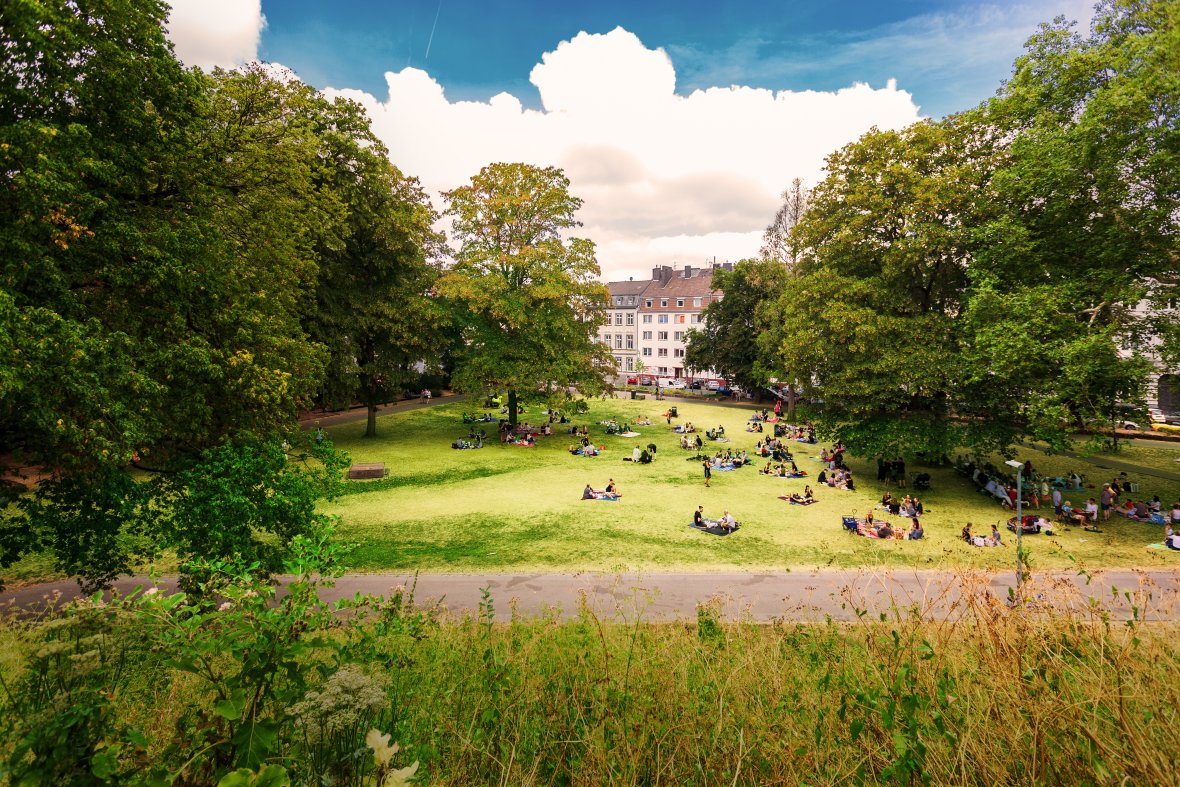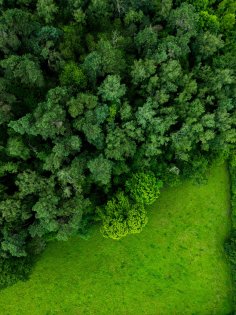Green in the city
The local recreational opportunities in the city of Aachen are characterized to a large extent by the special settlement structure that has resulted from its location in a valley basin on the edge of the Eifel with a large number of natural watercourses.

Following the topography and the natural course of the streams, green open spaces extend far into the city center. Within the settlement area, Aachen is richly endowed with parks of various sizes, some of which have the status of garden monuments as historical cultural assets.
The "Green Crown" of Aachen
Aachen's green open spaces range from forests close to the city to open landscapes, parks and gardens, playgrounds and sports facilities, cemeteries, avenues and green squares.
However, green open spaces and their quality are not evenly distributed throughout the city. Large and high-quality green spaces, which perform numerous important functions for the population, are not always located in Aachen's urban area where they are most needed: in neighborhoods where many citizens live.
And existing open spaces are often 'at risk': Aachen is - fortunately - one of the cities with dynamic urban development. But where buildings are built, open space has to make way. This increases the pressure in two ways: Green spaces are reduced by development and the remaining ones are used by more people.
As a result, the requirements and demands placed on urban green spaces in particular are constantly increasing. This also includes the need to adapt settlements to climate change and to compensate for pressures in people's living environment.
In view of these challenges, a strategy is required to take a holistic view of the significance and development of Aachen's open spaces and to relate them to one another. Aachen's open space concept "Die Grüne Krone" therefore describes guidelines and quality objectives in order to provide orientation for further action and the classification of projects.
Green oases in Aachen

Aachen city forest (Öcher Bösch)
Today, it is hard to imagine what Aachen's city forest must have looked like 150 years ago. Because until 1882, when the city council decided that the forest should also be used for recreation and not just as a source of firewood and acorns for pig farming, the trees hardly had a chance to grow higher than ten meters. Because by then they had already been cut down again. Today, the approximately 2,300 hectares of Aachen forest are a wonderful recreational area with numerous hiking trails. The mixed forest is popular with hikers and sports enthusiasts alike.
City park
Aachen City Park is a green oasis of around 200,000 square meters in the middle of the city centre. The beginnings of this large park can be traced back to 1853. From this time onwards, the city gardener Carl Jancke laid out a garden for the local hospital based on a design by Peter Joseph Lenné.
Elisengarten
With its grass steps and water features, it is the green park in the middle of the city center. An archaeological window clearly shows that many thousands of years of Aachen's history are hidden beneath its surface.
BorderRoutes
Hiking without borders - on 120 kilometers between Orsbach in the north and Raeren in Belgium in the south. Experience the landscape, culture and history of the three-country region. Whether through the vast hedgerow landscape of East Belgium, along rows of gnarled beech trees along the historic Landgraben, through the charming Göhltal valley or over the gentle hills of Limburg's Heuvelland - you can cross borders here.
Haarberg
The view from Haarener Kreuz across Aachen to the Netherlands and Belgium - it's worth it. Old varieties of fruit blossom in spring in Aachen's largest orchard. The Haarbach is one of the longest streams in the Aachen basin. The Haarbach valley fulfills an important function: fresh air is carried into Aachen's city centre when the wind blows from the east, which is all the more important when the weather is dominated by high pressure and there is hardly any air exchange.
Kaiser-Friedrich-Park
The park around the Hangeweiher pond is a green area that is primarily used by children. This is mainly due to the family-friendly residential environment, the large playground and the neighboring swimming pool. A lot of soccer is played on the large lawns, and in summer the pond can be used with pedal boats. The Italian terraced garden is a quiet spot for all age groups. Hermann-Löns-Allee begins at the Hangeweiher pond. Far away from major roads, its birch trees are the green trail into the Aachen Forest and the Von Halfern Park.
Kennedy Park
Kennedypark fulfills an important social function in the east of Aachen. It is a meeting place for young people and families, where cultural events and integration festivals take place. Among other things, there are several playgrounds and a skate park.
Kornelimünster / Walheim and Brand
Six of Aachen's twelve nature reserves are located in the Kornelimünster-Walheim district, the two largest in Brand (Indetal and Brander Wald). That speaks for itself. Streams, disused quarries and high forests characterize the landscape in the south of Aachen. The Inde, Iter and Fobisbach stream valleys also provide cool fresh air, which benefits the air quality in the surrounding districts. Many protected species live here, including the gray heron, the brook trout and the lamprey. Lurchi" is also at home here, as the fire salamander loves cold and clean stream valleys. Many rare plants now grow in the nitrogen-poor limestone soil of the old, abandoned quarries.
Lousberg and Müschpark
It is already a kind of landmark of the city - the Lousberg. In the past, the 264-metre-high elevation must have been largely bare: sheep grazed there. Most of the trees were only planted after 1807, when a citizens' committee and the city council of Aachen made a far-sighted decision: a landscaped garden should be created there, in the English style, as an open space and meeting place for all citizens of the city. This makes it the first park in Europe to be initiated by citizens.
Mighty trees from the founding period still thrive here today and bring history to life. This is also the starting point of the White Path, which leads along the beech avenue to the Lousberg Terraces. From their hammocks, you can enjoy the tranquil expanse of the Soers or hike on through the Müschpark to the Pferdelandpark.
Seven sources
With 80 liters of water per second, the Seven Springs in Seffent set a true bubbling record: No other spring within a radius of 70 kilometers is as productive. The water temperature is a constant nine degrees all year round. This protected spring biotope provides ideal conditions for aquatic organisms such as the freshwater shrimp and watercress.
Soers / Equestrian Park
The Soers is an ancient cultural landscape to the north of the Lousberg. It also serves as a fresh air corridor and supplies the city center with sufficient cold air, especially on cloudy days, which allows us to breathe better in Aachen. The Horse Country Park, a project realized as part of the EuRegionale 2008, opens up the Soers for those seeking recreation. The centerpiece is the White Path, a path enhanced with predominantly white-flowering plants that stretches across the Dutch border.
Von Halfern Park
Friedrich von Halfern was not only a successful cloth manufacturer, bank director, city councillor and chief fire officer of the Burtscheid fire department, he also had a passionate interest in trees. He planted numerous trees from many distant countries on the 10-hectare plot between Lütticher Strasse and Preusweg that he inherited from his father. 81 deciduous trees and 51 conifers can still be admired there today, adding to the exoticism of one of Aachen's most beautiful parks.
Westpark
The fact that the RWTH and the University of Applied Sciences can't be far away becomes clear on balmy summer evenings at the latest. This is when many students use the meadows of the Westpark for barbecues, which are permitted until 10 pm. During the day, parents stroll through the park with their children. Some admire the gnarled, 180-year-old ash tree that grows on the western edge of the small pond. It was already there before the zoo was located here (1880-1920).
GoGreen
Research project on greening buildings and sites
The aim of the project is to improve the feasibility of greening buildings and sites. In this way, the proportion of climatically effective green spaces can be increased at municipal level and previously untapped potential for adapting to climate change can be activated.
Obstacles to implementation and possible solutions to overcome them will also be identified. One focus of the project is on investigating the motivation and acceptance factors of different target groups as well as the process of communication and participation.
One result of the project is the development of a concept to improve the feasibility of greening buildings and properties in the two cities of Aachen and Eschweiler. This includes an implementation roadmap tailored to the two municipalities. In addition to the selection and prioritization of measures, this includes a strategy for communication and organization. Selected measures are to be implemented as examples in the form of a "real-world laboratory".

